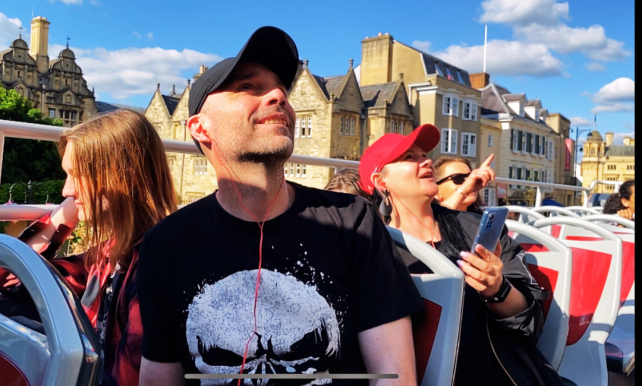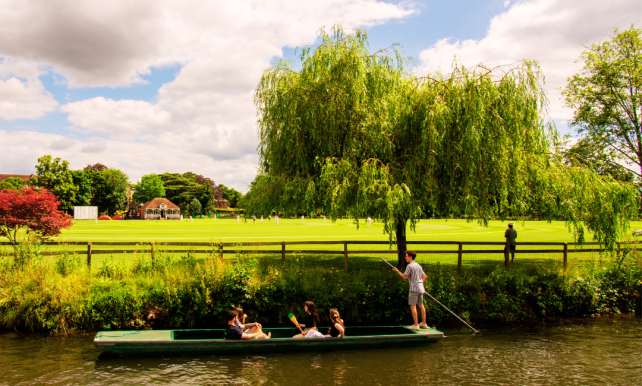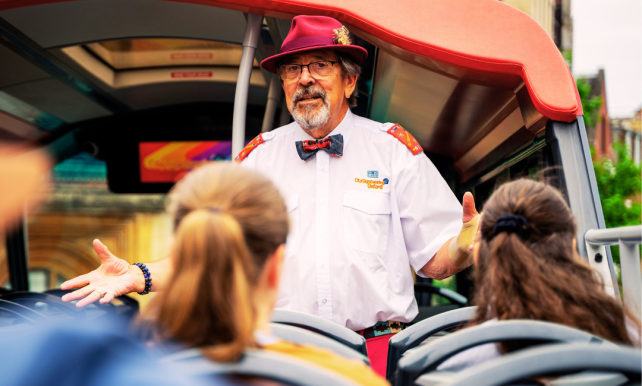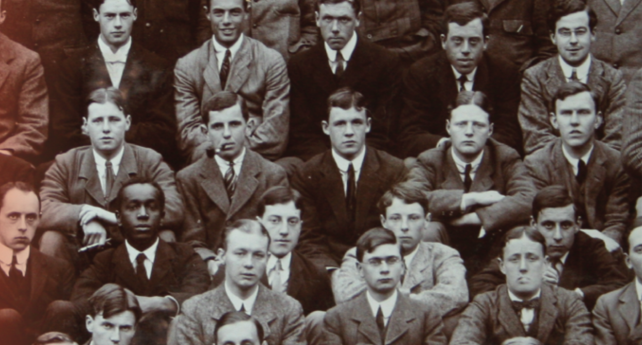Bainton Bikes – River Thames and Oxford Canal
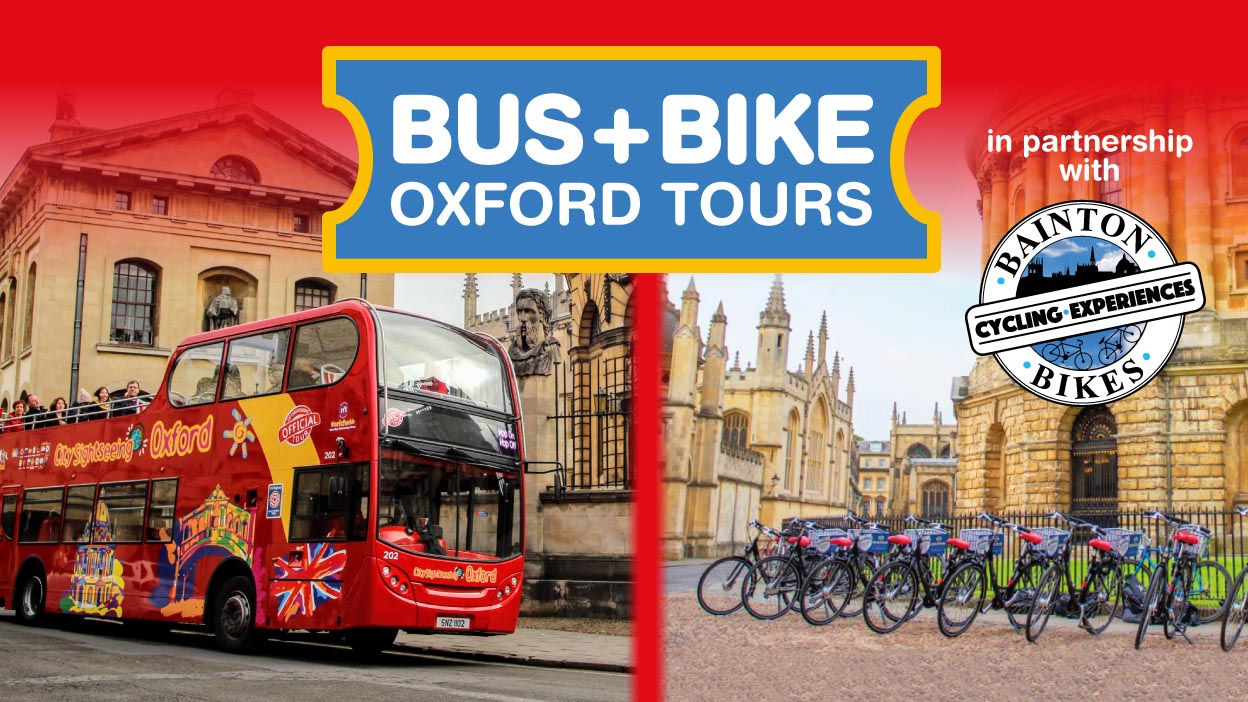
Bike and Bus Tour: Off the beaten track, The River Thames and Oxford Canal
Tour summary
A circular tour taking you off the beaten tracks into Oxford’s peaceful countryside waterways, with plenty of places to enjoy a picnic, take a river swim or enjoy some fantastic food or drinks in atmospheric locations.
Recommended duration: 2 to 3 hours (depending on stoppage times for swimming, food and drinks)
Distance: 6.2 miles
Map overview
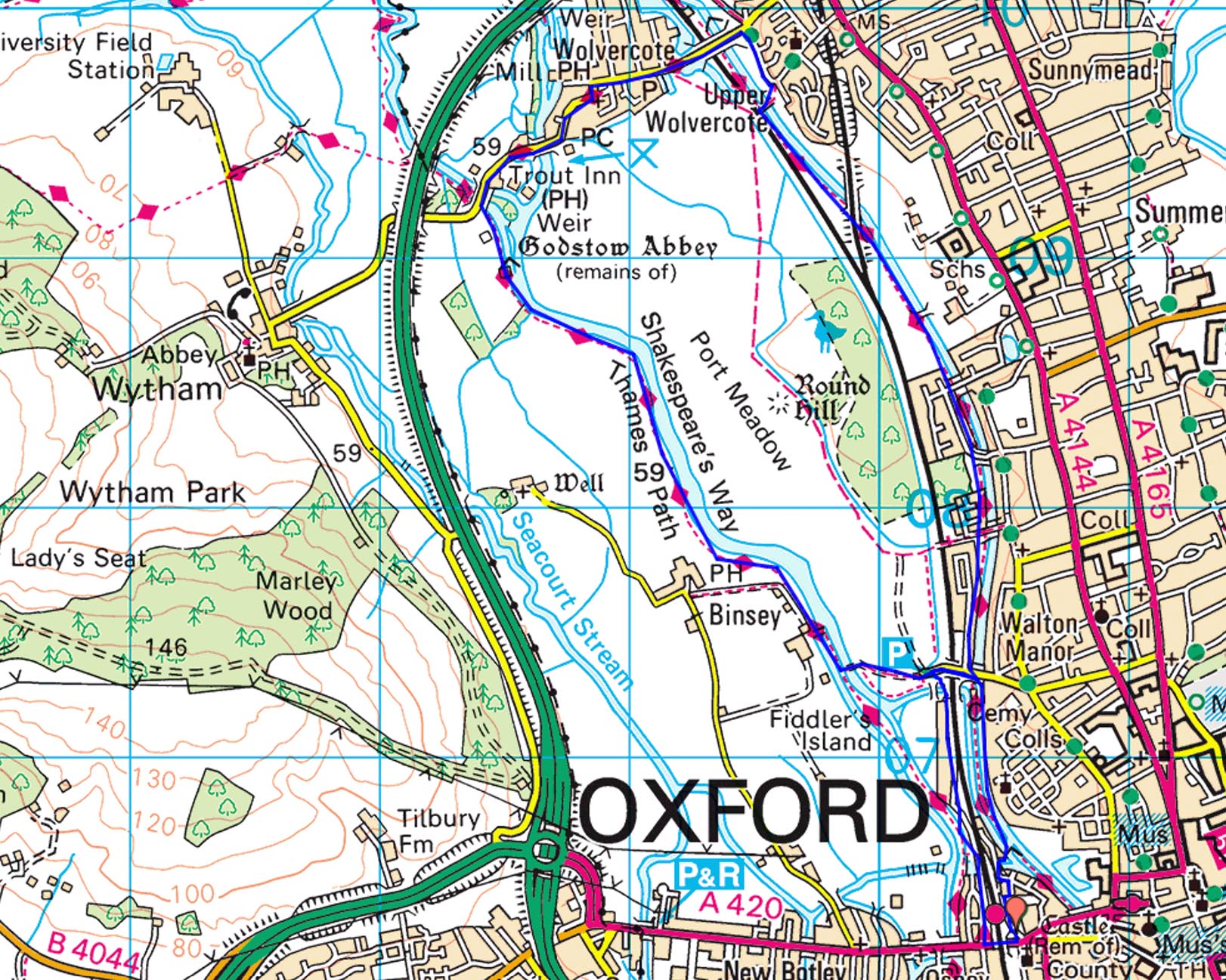
Directions and points of interest summary
- Depart the City Sightseeing Oxford bus at stop 1 – Oxford Rail Station.
- Collect the hire bikes from the cycle parking at Oxford Rail Station.
- With the train station entrances on your left and the main cycle parking area behind you, go past the bus stops and taxi ranks over the zebra crossings heading towards the Thatcher Business Education Centre.
- Follow the cycle path past the Thatcher Business Education Centre (so that the building is on your right).
- Turn left onto Rewley Road.
- Follow the road round as it bends right.
- Join the Oxford Canal on the right over the bridge.
- When on the canal path, turn left (heading away from the train station).
Point of interest: The Oxford Canal - Leave the Oxford Canal path at bridge 242.
- Turn left onto Walton Well Road.
- Follow the road all the way down to the entrance to Port Meadow.
Point of interest: Port Meadow - Cross Port Meadow on the track heading towards the river.
- When you reach the gates for the bridge, cross over the bridge and turn right so the river is on your left-hand side.
Point of interest: The River Thames or Isis - At the footbridge (Rainbow Bridge), cross over the bridge and continue on the path to the right, so that the river is on your right-hand side.
Point of interest: Medley Manor Farm
Point of interest: The Perch
Point of interest: Binsey Treacle Well – just off the track - Continue along the River Thames path until you reach the Godstow Nunnery ruins.
Point of interest: Godstow Nunnery - After the nunnery, exit the gate and join the road turning right to go over the bridge.
Point of interest: The Trout Inn - Follow the road through the village of Wolvercote and when you reach the roundabout by the Jacobs Inn and The White Hart, turn right onto Godstow Road.
- After you cross the bridge with traffic lights that go over the railway lines, turn right onto Wolvercote Green.
- When you see the Plough Inn (another great place to stop for a drink or food), take the off-road track to the right heading towards the Oxford Canal.
- Join the canal at bridge 236 heading to your right so that the canal is on your left-hand side.
- Continue on the canal until you reach bridge 242. Here you will need to turn right as you pass under the bridge and leave the canal.
- Turn left onto Walton Well Road and proceed back towards the entrance for Port Meadow until you see a pedestrian and cycle path on your left-hand side just before the Walton Well Road car park.
- Turn left onto this path.
- Follow the path as it turns into a residential road past the accommodation on Roger Dudman Way.
- At the end of Roger Dudman, way turn left onto Botley Road and head under the railway bridge.
- At the roundabout turn left into the Oxford Rail Station.
- End of the tour, lock the bikes at the Oxford Rail Station cycle parking facilities.
Points of interest
The Oxford canal opened in 1792, and overnight the price of coal halved in price. The Oxford canal connects the city with the network of canals that extend from East Anglia to the West Midlands and was an important trade artery between the Midlands and London. Canals are ancient man-made constructions dating back as far as Roman times.
In 18C and 19C the canal was used solely for transporting freight up and down the country. This was one of the most important transport links in Britain. Its principal traffic was coal from Warwickshire but with the advent of the railway, the industry declined. Boatmen were no longer able to afford their houses so they converted their boats into homes. Thriving communities grew up; in fact, in 1838 the houseboat community was so large that a floating chapel was moored near Hythe Bridge. The track you ride down would have been full of horses as late as the 1950s as the boatmen preferred horse-drawn boats long after others had converted to diesel power.
Port Meadow is a large area of common land which stretches between the canal and the River Thames (known here as the Isis) from the village of Wolvercote to Jericho. This beautiful meadow has never been ploughed since it was given to the Freemen of Oxford by Alfred the Great (one of the founders of Oxford) in return for defending the city from the Danes. The meadow is mentioned in the doomsday book and amounts to 400 acres of land protected from development. The Freemen of Oxford (Honoury status) still enjoy the right to graze animals here and you’ll see plenty of people still exercising it with their cattle and horses. This is a flood meadow and so the winter months bring wetland birds and ice-skaters here. Port meadow has a military history too. King Charles I billeted his forces here during the English Civil War until he escaped out of Oxford and made a dash for the West Country with his 5000 men. During WW1, a military airfield was based here and during WWII it was a camp for military personnel evacuated from Dunkirk. You will be cycling down the river path along the Thames (Isis) where Charles Lutwidge Dodgson (aka Lewis Carroll) and three little girls Loriana, Alice and Edith, daughters of the Dean of Christ Church college, went boating on a summers day, July 4th 1862. That’s when he began to spin the tale which became ‘Alice’s adventures in Wonderland’, the story of a bored little girl called Alice who falls down a rabbit hole into a magical land. The girls loved the story and Carroll elaborated it on future boat trips eventually writing it down when Alice asked for a copy.
With a total length of 215 miles (346 km), the Thames is the longest river entirely in England and the second-longest in the United Kingdom. It rises at Thames Head in Gloucestershire and flows into the North Sea via the Thames Estuary. On its way, it passes through a number of cities, towns, villages and hamlets including London, Oxford, Reading, Henley-on-Thames and Windsor. The Thames through Oxford is sometimes given the name the River Isis. Historically, and especially in Victorian times, gazetteers and cartographers insisted that the entire river was correctly named the River Isis from its source down to Dorchester-on-Thames and that only from this point, where the river meets the River Thame and becomes the “Thame-isis” (supposedly subsequently abbreviated to the Thames) should it be so-called. Ordnance Survey maps still label the Thames as “River Thames or Isis” down to Dorchester. However, since the early 20th century this distinction has been lost in common usage even in Oxford, and some historians suggest the name Isis is nothing more than a truncation of Tamesis, the Latin name for the Thames.
A small family-run farm open to the public during summer months, offering ‘Pick Your Own’ on seasonal fruit and veg. They also have a number of bees with a limited amount of local honey and seasonal ice cream available.
New for 2021 is the Medley Manor farm bar offering nice riverside drinks and snacks from their café.
The Perch is a 17th-century pub which is owned by Christ Church. It has been made famous by Gerard Manley Hopkins in his poem Binsey Poplars written about the riverside tress he found felled as well as a setting where Lewis Carroll (who regularly frequented the pub) first gave public readings of his Alice in Wonderland novel.
Just off the route in Binsey within the grounds of the 12th-century church of St. Margaret’s (visit by walking through the front door of the Perch) is Binsey Treacle Well (St. Margaret’s well), a Grade II listed building which is most famed by Lewis Carroll’s story of Alice in Wonderland “Treacle Well”.
The original story of the well predates Lewis Caroll. It is a holy well dedicated to St Frideswide, patron saint of Oxford. She had fled to Binsey in a bid to escape marriage to a king of Mercia, whose pursuit of her was halted when he was struck blind at the gates of Oxford. Frideswide’s prayers brought forth a healing spring, whose waters cured his blindness, and the spring was walled into a shallow well which became a focus for pilgrimage, the mediaeval sense of the word ‘treacle’ meaning ‘healing unguent’. The well became a pilgrimage site in medieval times.
Today, all that remains of Godstow Nunnery are the outer walls and the tiny St Leonard’s chapel, which still provide enough to give an impression of what it must have been like up to a few hundred years ago. A 10C noblewoman and widow Edith founded a Benedictine nunnery here. It became rich and grew after endowments from Henry II to tend the tomb of his long-term mistress and noted beauty Rosamund who spent the last month of her life here. Her tomb in front of the high altar became something of a local shrine until after Henry’s death when the Roman Catholic Church began a campaign against Anglo-Saxon traditions of marriage and nobility. Rosamund was called a ‘harlot’ and her body exhumed and moved out of the Abbey where it remained until Henry VIII’s reign. The ancient nunnery was handed into private ownership during the dissolution of the monasteries and its later destruction was ordered by Sir Thomas Fairfax during the English Civil War.
The Trout Inn is a 17C public house perhaps best known in modern times for featuring in an episode of Inspector Morse. The land was once owned by Godstow Nunnery and in 1138 a guest house was built on the site to accommodate passing pilgrims and as a hospice for the nunnery. In those days, nunneries did not enjoy the spotless reputation they have today. They were a refuge of last resort for many women and this lead to suspicion of them as houses of indiscipline and easy virtue. Aware of Godstow’s particularly racy reputation for offering ‘hospitality’ to the monks of Oxford the Archbishop of Canterbury forbade the nuns to mix with Oxford scholars.


